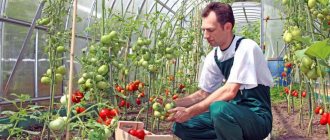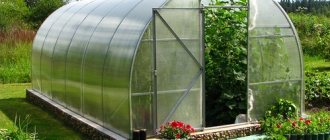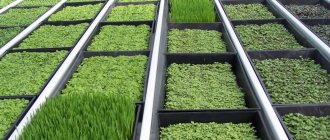In the current economic situation, it is more profitable to start your own business than to depend on external circumstances. Drawing up a business plan for a greenhouse for growing vegetables will not be difficult if you decide in advance on the parameters of the greenhouse, the products to be grown, the sales market and the amount of money invested.
Greenhouse farming
Infographic: Greenhouse business from scratch
Take our proprietary course on choosing stocks on the stock market → training course
| Business valuation | Financial analysis according to IFRS | Financial analysis according to RAS |
| Calculation of NPV, IRR in Excel | Valuation of stocks and bonds |
Risks
This section is of great interest to all investors, regardless of their field of activity. It may not be a harvest, or maybe the market is saturated with products at the given time.
Contracts for processing products, such as canning, will have a great positive effect. In this case, you can conclude a protocol of intent with any processing enterprise. And show the investor that even in this case there will be benefits.
The most important thing is a greenhouse business plan so that you can see the positive effect of investing money and provide for all the nuances that apply specifically to your region.
Introduction to the greenhouse business. What's best to grow?
First of all, you need to decide what kind of greenhouse you want to organize, since they differ in the type of assembly. This partly depends on what vegetables you grow. Once you've done this, it's time to start solving organizational issues.
In short, you need to contact buyers or find other outlets for selling products. Only after this can you begin building a greenhouse, organizing a workplace and purchasing the necessary equipment.
Please note: if you are good at working with your hands and do not plan to start with large volumes right away, then you can build your first greenhouse yourself. In this case, you will save significant money.
There are 3 main branches of the greenhouse business: vegetable, flower and herb growing . It is worth noting that the latter is the most profitable at the moment. The greatest profits are received by those businessmen whose greenhouses are located in the southern regions of the country. Why? Firstly, because the costs of transporting products are significantly reduced. And, secondly, in the southern regions you will not have to deal with the cold, which can cause great losses.
Reviews from our clients
Feedback on the business plan for an industrial year-round winter greenhouse for growing vegetables.
The business plan for the greenhouse, developed by the Plan-Pro team, allowed us to attract private investment in the amount of 30 million rubles. During the work, the company's consultant demonstrated deep professionalism and understanding of the specifics of our project. The investors agreed to work with us, so thank you very much.
Alena Podkaminskaya, Commercial Director, Yaroslavl
Feedback on a business plan for a hydroponic greenhouse for growing strawberries and vegetables
We needed a high-quality business plan to plan a strategy for the further operation of a hydroponic greenhouse; and contacted Plan-Pro. We liked the finished business plan. The descriptions and calculations are extremely clear and logical; there is no need to think about where each figure comes from. Easy to make changes and edits. The financial model and the product itself are at a good level.
Dmitry Korolenko, Naberezhnye Chelny
Feedback on a business plan for growing strawberries in open ground
A business plan for growing strawberries was downloaded from the website plan-pro.ru: simple diagrams and formulas, a comprehensive assessment of the project’s payback. Thanks to this plan, they were able to obtain a loan of 20 million rubles from Rosselkhozbank for the development of a project for growing strawberries in open ground.
Natalya M.V., Krasnodar region
Feedback on a crop farming business plan for growing wheat and other grain crops
We managed to attract a private investor and receive financing in the amount of 140 million rubles. The business plan for growing grains was developed according to the UNIDO standard. The document turned out to be clear, all our wishes and the specifics of the industry were taken into account.
Lyubov Andreevna, farmer, Voronezh region
Review of a mushroom farm business plan for growing champignon mushrooms
We received a loan of 70 million rubles from Sberbank for the development of a mushroom farm for growing champignons . Thanks to Plan-Pro for a high-quality business plan. A good marketing research was carried out, the break-even point was calculated, and the expected income and expenses of the company were reasonably calculated.
Igor Nikolaevich, Tambov
Feedback on a greenhouse business plan for growing vegetables
Having decided to start my own business, I chose greenhouse farming. There are reasons for this: I know the technology of this business well, and the area itself contributes to my choice - the Krasnodar Territory. My problem was attracting outside investment, which required a solid business project. I purchased a ready-made business plan for a greenhouse complex A clear and understandable system of calculations and payback forecasts presented in it allowed me to easily obtain a loan from Sberbank in the amount of 15 million rubles, as well as apply for a state subsidy for the development of agriculture
Podyukov E.V. Krasnodar region.
How to open a greenhouse business: preparation
Greenhouse farming is developing and improving very quickly. In addition, there is a lot of competition in this area, which leads to a decrease in profit margins. Despite this, technology is still changing rapidly, and equipment costs are also rising.
★ Investment assessment for a business plan in Excel. Calculation of NPV, IRR, DPP, PI in 5 minutes
⊕
Thus, to keep your business afloat, you need to be aware of all developments, expand on time and use the latest technologies. A business plan will help you cope with all these tasks. It consists of the following steps:
- assessment of the situation in the field;
- division into seasonal or permanent business (for seasonal business, ordinary greenhouses are sufficient, while for permanent business, only special industrial greenhouses with year-round heating are suitable);
- creating relationships with wholesalers and assessing sales opportunities;
- creating a business plan and calculating profits and expenses;
- comprehensive development of a business plan;
- financing.
The first thing you need to do when creating a business plan is to outline an investment plan.
The first cost will be associated with obtaining design documentation for the greenhouse and external networks. It must include specifications for all equipment. Please note: you must know the exact price of each piece of equipment.
Hydroponics is the most popular type of growing. Typically this technology is used for different types of vegetables. If you organize everything correctly, the cycle will take a couple of weeks, that is, 5-10 times faster than the usual vegetable cycle. At the same time, from one hectare you will receive 2-3 tons of harvest every day. You can also indicate 7 workers per 1 hectare in expenses.
How much profit can you get from growing vegetables?
The level of income is influenced by the seasonality factor. Most often, prices for agricultural products reach their maximum in spring and winter. If grown tomatoes or cucumbers are sold during this period, their cost will be in the range of 80-120 rubles. for 1 kg.
If you focus on a greenhouse with an area of 1000 sq.m. with a harvest of 16 tons per month and a price of 80 rubles. for 1 kg we hope for 100% of its implementation, the monthly income will be 1.28 million rubles.
Greenhouse with an area of 1000 sq.m.
To calculate net profit, you need to subtract constant investments from this amount - 350 thousand rubles. The result will be 930 thousand rubles. You can only have income of this size for six months. During the warm season of the year, the cost of production decreases several times. But even taking this into account, the project will pay for itself in 9-12 months if everything is organized correctly.
How to open a greenhouse business: creating a business plan
First of all, you will need to determine the location of the land plot itself, its area. After which you will need to make a decision about what vegetables (greens, flowers) you will grow, and how much area will be allocated for each type. Then you need to specify the growing method you will use.
After this, approximately calculate how much harvest you plan to receive per square meter per year (for each type of product separately). With this short plan, you can determine what you already have and what you need to buy or do.
Object characteristics
Type of activity: crop growing; growing vegetables and flowers in greenhouse complexes for subsequent sale.
OKVED: “Crop Growing”:
- No. 01.13.12 “Growing vegetables in protected soil.”
- No. 01.19.2. "Floriculture".
Address: the land plot is located in a rural area. The future entrepreneur has the right of ownership to this territory. The land has not been cultivated for several years, so the soil is not depleted. There is a source of water and electricity. Gasification is not provided.
Form of legalization of activity: LLC.
Taxation: Unified Agricultural Tax (6% of the difference “income minus expenses”).
Schedule:
Every day from 08:00 to 18:00.
Product shipment from 08:00 to 18:00.
List of events:
- Growing vegetables (cucumbers, tomatoes).
- Growing flowers (in assortment).
- Wholesale sales of vegetables to retail chains.
- Wholesale sale of flowers to flower shops.
- Work on creating new varieties of vegetables and flowers.
Project goals and total cost
Think about which communities are located near your greenhouses. If you manage to deliver products there, you will significantly reduce transportation costs.
The next goal is to sign an agreement with a large corporation (supermarket chain, food preparation factories, etc.). However, this depends on how large your greenhouse operation is.
The last goal is to determine the maximum profit for the year from the available resources and the minimum profit at which you can develop in the next year. It is desirable that these 2 numbers are very different from each other and are much above the loss line.
To calculate the total cost of greenhouse farming, you need to determine what expenses you will incur. First, find out the initial capital. This amount of funds should ensure the direct construction of greenhouses, their connection to various networks (water, electricity, etc.), the purchase of equipment and planting material. You should also not forget about the ongoing expenses that will occur before you receive your first profit.
Search for product sales channels
Of course, products grown in a greenhouse all year round can be sold independently, but it is safer to establish sales channels with large and small wholesalers:
- vegetable bases;
- markets;
- large retail chains;
- shops;
- catering organizations.
Project preparation time
To determine not only the volume, but also the time of profit, it is necessary to make several calculations:
- preparation of the territory, construction of greenhouses and their connection to networks must be carried out in T-time (you can find out this figure if you take into account the number of workers, the type of greenhouse and its size);
- acquisition of equipment and its installation;
- purchasing and planting planting materials;
- Based on your work strategy, determine the timing of crop ripening;
- terms of sale of goods.
As a result, you will be able to determine the approximate time of profit. Please note: if your contract with the customer does not provide for immediate payment upon receipt, and you receive money based on the quantity of products sold, then the average period of damage to the crop must be added to the above formula.
You need to start your business by searching for wholesale buyers who will be ready to purchase your products: wholesale centers, stores, markets.
Industry Analysis
Analysis of the industry in which a novice businessman wants to occupy his niche requires a mandatory study of possible sales channels, as well as a detailed examination of his potential competitors, identifying their strengths and weaknesses.
Market analysis
Before starting a business, you need to consider a number of important factors on which the success of your business significantly depends. One of them is an analysis of the market (in fact, sales channels) existing in the region where the future farm is located. If the market in your locality and surrounding areas is oversaturated with vegetable products, then there are several options:
- choosing a landing site in another area;
- identification of vegetables, the quantity of which does not meet the needs of the population;
- growing popular crops and trying to penetrate an oversaturated market through various marketing strategies. However, it is worth understanding that this option is associated with significant risks.
Competitor analysis
When analyzing existing competitors, you should pay attention to the following points:
- number of existing competitors;
- volumes and types of crops they grow;
- competitors' pricing policy;
- searching for the weaknesses of competitors in order to strengthen these areas when developing your business.
Risk analysis
As with any type of business, there are certain risks, the main ones being:
- a large correlation between energy prices and the cost of finished products when grown in a heated greenhouse;
- existing diseases of vegetable crops and pests that can significantly reduce or completely eliminate the amount of harvest obtained;
- constantly changing demand for certain crops and the need to constantly monitor the expected amount of harvest of a particular crop in your region;
- the risk of food spoilage due to a large crop harvest or its high cost at a certain period of the year;
- the risk of overstocking with unsold products if too much quantity is produced.
Competition in the greenhouse segment
There is no point in learning about how to start a greenhouse business if you are not competitive. It is necessary to determine the specifics of greenhouse farms that operate in this region. Pay special attention to the type, quantity and quality of the products they offer.
To be competitive, it is necessary to determine how full the sales market is and what the demand is among the population. Even if you have found one or more wholesale buyers, you need to take into account the fact that after some time they may go bankrupt, and you will have nowhere to sell your products. Therefore, it is best to have backup options for selling products.
Brief investment memorandum
The greenhouse business is more relevant today than ever.
This is due to two main factors. Firstly, the popularity of healthy eating is increasing every day, and people are starting to eat more and more fresh herbs, vegetables and fruits. Secondly, due to the political situation, the import of foreign products is limited. Accordingly, the demand for domestic products is growing. The state supports agriculture by reducing tax rates and often subsidizing it. Thus, we can conclude that business in this niche is a very attractive and promising business. Greenhouse farming does not require high investments, and they will pay off in a very short time.
To achieve maximum efficiency, you must initially draw up a business plan, calculating all the details of the business. This project is designed for the central part of Russia.
Main advantages:
- small investments;
- growing demand for domestic products;
- the ability to use the product for your needs;
- low maintenance costs, especially in summer;
- low tax or no tax;
- simple business organization.
The amount of initial investment is 1,000,000 rubles.
The break-even point is reached after 5 months of operation.
The payback period is 16 months.
The average monthly profit from the project is 89,000 rubles.
Return on sales 31%.
Technical and financial nuances
Having understood all the above issues, it’s time to get acquainted with the intricacies of production:
- Remoteness of communications from your greenhouses. The fact is that the connection will be carried out entirely at your expense. Therefore, you need to consider these additional costs.
- Size of territory. It should be such that you can easily organize access roads for transporting your goods.
- If you do not have enough funds to purchase a plot of land, you can rent it. But in this case, it would be inappropriate to build greenhouses - it is best to purchase prefabricated greenhouses.
- Heating of greenhouses. Allows you to clearly regulate the temperature inside the greenhouse and control the growth of vegetables.
- Free finance. The availability of free funds will allow you to invest in new technologies, marketing or scale existing business processes.
★ Investment assessment for a business plan in Excel. Calculation of NPV, IRR, DPP, PI in 5 minutes
⊕
Planning according to the calendar
Putting a greenhouse into operation takes a lot of time, because there is not a single building or communications on the land plot. Each stage can last from two weeks to several months, especially laying communications, pouring the foundation, landscaping the territory, erecting and equipping buildings. The preliminary schedule of work to create a greenhouse complex is shown in the table:
| Procedure | Period | |||||||
| 03 | 04 | 05 | 06 | 07 | 08 | 09 | 10 | |
| Submission of documents for registration of activities, development of an enterprise project on paper with an architect and representatives for the production of greenhouse complexes | + | |||||||
| Coordination of the construction of greenhouses and other facilities on the selected site with the administration and regulatory agencies | + | |||||||
| Conclusion of an agreement for the manufacture and installation of greenhouses. Drawing up construction estimates for additional facilities. Beginning of work | + | |||||||
| Preparing the foundation for greenhouses. Work on installing water supply, electricity, sewerage, sewage systems. Application Form | + | |||||||
| Assembly of greenhouse complexes, equipment with irrigation, ventilation, heating, lighting systems | + | + | ||||||
| Finishing work in the administrative and warehouse complex. Ordering furniture, software, communications equipment, surveillance systems for the territory | + | + | ||||||
| Arrangement of the adjacent territory, construction of fences | + | + | ||||||
| Personnel selection. Ordering seeds and seedlings for the first planting in the ground | + | + | ||||||
| Search for clients and points of sale for vegetables and flowers | + | + | ||||||
| Planting seedlings in the ground. First care work | + | |||||||
| Advertising campaign | + | + | + | |||||
| Concluding agreements with clients | + | |||||||
| Official start of the facility’s activities | + | |||||||
So, by the end of October, the greenhouse should begin operating at full capacity and begin harvesting the first harvest of cucumbers or flowers, unless unforeseen circumstances arise. At this time, vegetables from the store begin to be in great demand, because private gardens have already closed their season. The cost of one kg is significantly higher than in the summer season, which makes it possible to make a greater profit.
With flowers, of course, we missed the seasonality (September 1), but there are other events ahead when bouquets are no less popular.
Example of greenhouse business calculations
Let's take a look at the approximate calculation of how to open a greenhouse business :
- one greenhouse with all equipment and an area of 0.5 hectares will cost $15,000;
- to service it you need to hire 5 people: 3 workers, a manager and a technologist (salary $25-30,000 per year);
- 90% of expenses are heating and electricity, so you need to find the cheapest, but at the same time effective way (it is best to choose species for which the growing temperature does not differ much from the temperatures in the region - this will reduce variable costs);
- business profitability is 15-40%, that is, your expenses will pay off in a couple of years (depending on competition and demand in a particular region).
| Business valuation | Financial analysis according to IFRS | Financial analysis according to RAS |
| Calculation of NPV, IRR in Excel | Valuation of stocks and bonds |
Personnel selection
The enterprise for growing greenhouse crops is serviced by hired personnel. It is difficult to care for a 1000 m2 greenhouse on your own.
Table 2. Employee salaries
| No. | Job title | Salary per month, rubles |
| 1 | Agronomist | 18000 |
| 2 | Two workers | 40000 |
| 3 | Two movers | 30000 |
| 4 | Equipment maintenance specialist in case of breakdown | 10000 |
| 5 | Outsourced accountant | 15000 |
| 6 | Driver | 25000 |
| 7 | Two guards | 40000 |
| Total payroll | 178000 | |
| Taxes | 26700 | |
| Total payroll with taxes | 204700 |
The functions of a manager and a sales manager can be combined and performed by the entrepreneur himself. The number of employees may vary depending on the seasonality of the business and the variety of crops grown.











